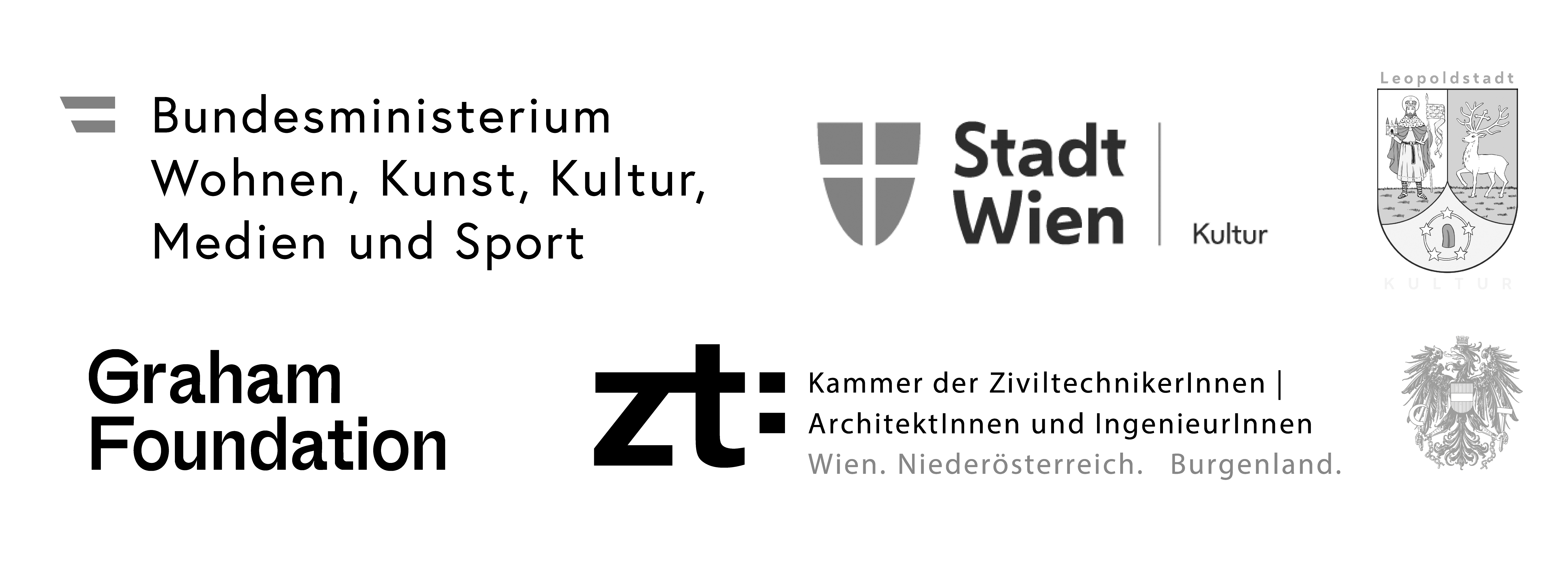WEERKAS by JOHAN VOORDOUW
The Weerkas is an ironic commentary on changing weather patterns in the Netherlands. Each image illustrates a specific geographic location in one of the Netherlands’ twelve provinces, in one month of the year. The drawings express a shift in weather conditions, and speculate the social and economic implications of climate change on the Dutch landscape. The small Weerkas interventions act as a didactic ‘follies’, expressing the increasing disparity between historic, normative climate cycles and emerging weather conditions. These weather anomalies will have a dramatic affect on the country’s economic and cultural future.
These projected drawings are afforded new spatiality in Vienna, re-drawing the images to a new space, for a new time. In this evolving operative capacity, the drawings are actualized, not as images of architectural forms in the landscape, but as architectural lines forming space.

12 months of the year are presented in 12 cad-perspectives drawn onto the walls of the exhibition space
 Each drawing depicts an architectural intervention into an iconic Dutch landscape: an implant that re-installs its historic and distinct weather condition
Each drawing depicts an architectural intervention into an iconic Dutch landscape: an implant that re-installs its historic and distinct weather condition
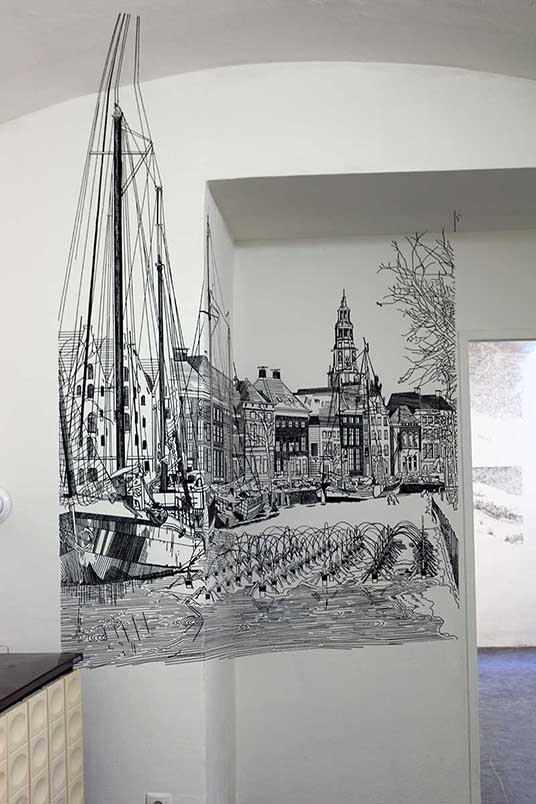
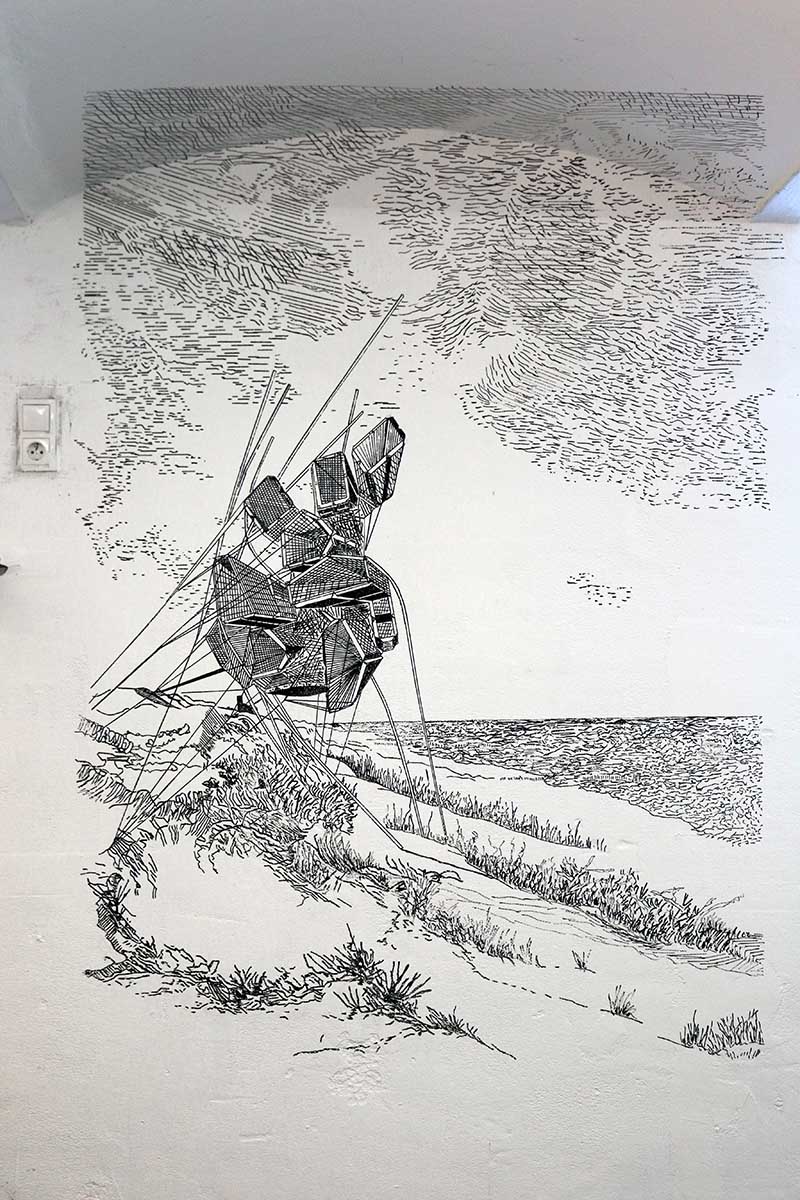
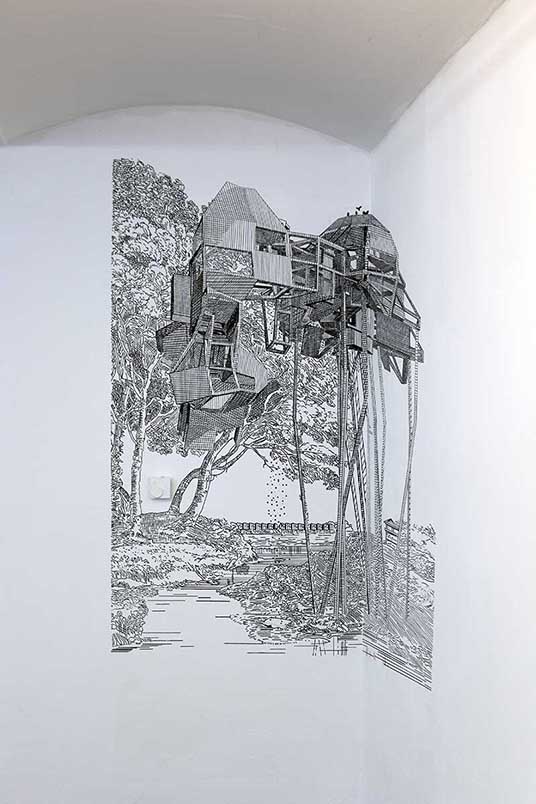
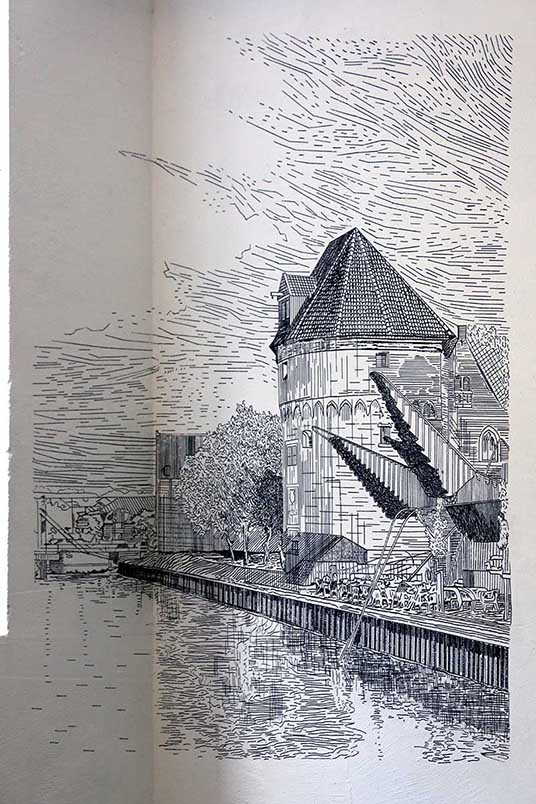



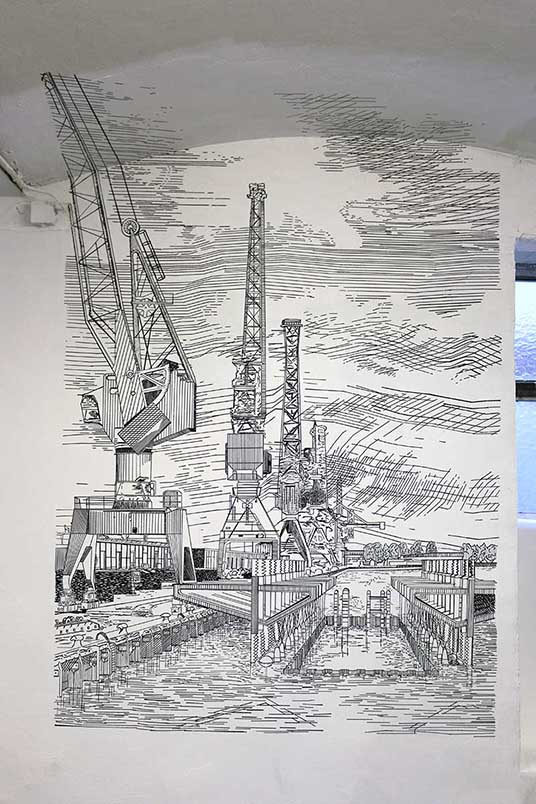

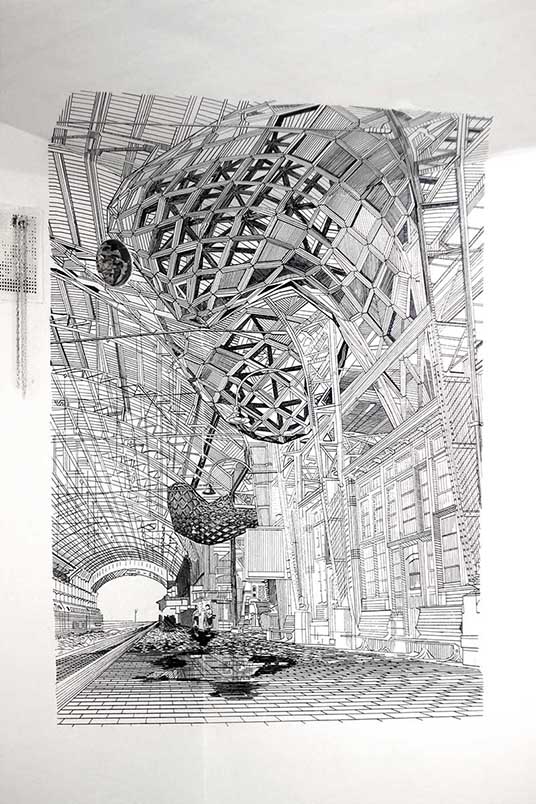
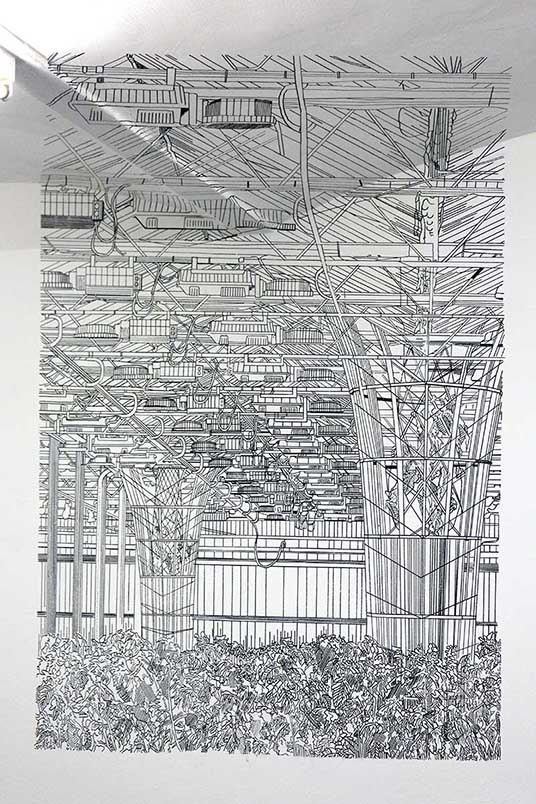
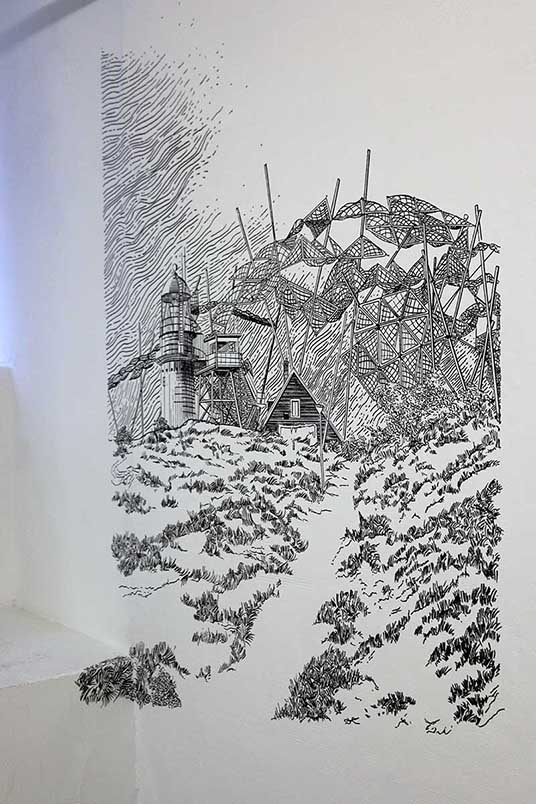
WEERKAS
Completed for an open call to the ‘Urban by Nature’ International Architecture Biennale Rotterdam, the Weerkas is an ironic commentary on changing weather patterns in the Netherlands. Each of the twelvedigital drawings expresses a shift in weather conditions, and speculates the social and economic implications of climate change on the Dutch landscape. The portfolio of drawings expands across Dutch space and time. Each image illustrates a specific geographic location in one of the Netherlands’ twelve provinces, in one month of the year.
The project title – Weerkas - loosely translates to ‘Weather-house’. This is not a ‘house’ in a domestic sense (huis),but a translation of the word ‘kas’ (greenhouse). The greenhouse was an importantinspiration for the project. Greenhouses construct the country’s ground plane and represent the modern Dutch landscape par excellence. It is this set piece, and it related sense of environmental control that is subverted and called into question in the Weerkas project. Because of climate change the Dutch landscape is undergoing enormous undesirable change. The overtmanagement that the country exerts over of its land and waterwill in the coming decades become increasingly variable and difficult to predict and control.
The small Weerkasinterventions act as a didactic ‘follies’, expressing the increasing disparity between historic, normative climate cycles and emerging weather conditions.Given the homogenous geography of the Dutch landscape, these weather anomalies will have a dramatic affect on the countries economic and cultural future.
The drawing technique used in the drawings references the historic landscape etchings produced in Holland’s Golden Age of art in the 17th Century, tying the contemporary narrative of climate change to historic expressions of the Dutch landscape. The environmental and cultural function of each structureis underscored through textual research of academic journal articles,and, in particular, the documents published by the KoninklijkNederlandsMeteorologischInstituut (KNMI) – Royal Netherlands Meteorological Institute).
Each image considers different aspects of the weather:
January is the Ijskas. It considers ice making in Groningen, a realization that with a small increase in winter temperatures the historic cultural phenomenon of skating on the frozen canals will become an activity relegated only to memory
February is the Windkas. Increasingly winter wind patterns are shifting from the cold northern winds of Norway to warm winds from Spain. This folly takes warm winter wind, cools it in its large funnels and flips its directionto become cold northernly winds
March is the Sneeuwkas. This folly forms a square meter of snow on the ground on the three days in March when snow ought to fall. In this image the tree is already in leaf as spring has yet again arrived a couple weeks early
April acts like a large air conditioner, taking in cold canal water to absorb ambient heat and dumping it back into the water. A warm April is poor for the Dutch cut flower industry, which is an integral part of the Dutch identity
May expresses the increasingly volatile weather that will adversely affect delicate ecosystems through harmful windstorms. Here the interior sand dunes of the Loonse en Drunense Duinen are protected from the worst of the inclement weather through a series of protective barriers that illustrate the harmful effects of wind erosion
June is located at the KNMI headquarters in De Bilt, building a large scaffold with a barometer for each of the Netherlands’ 36 weather stations showing historic barometric pressure as oppose to the present conditions
Completed for an open call to the ‘Urban by Nature’ International Architecture Biennale Rotterdam, the Weerkas is an ironic commentary on changing weather patterns in the Netherlands. Each of the twelvedigital drawings expresses a shift in weather conditions, and speculates the social and economic implications of climate change on the Dutch landscape. The portfolio of drawings expands across Dutch space and time. Each image illustrates a specific geographic location in one of the Netherlands’ twelve provinces, in one month of the year.
The project title – Weerkas - loosely translates to ‘Weather-house’. This is not a ‘house’ in a domestic sense (huis),but a translation of the word ‘kas’ (greenhouse). The greenhouse was an importantinspiration for the project. Greenhouses construct the country’s ground plane and represent the modern Dutch landscape par excellence. It is this set piece, and it related sense of environmental control that is subverted and called into question in the Weerkas project. Because of climate change the Dutch landscape is undergoing enormous undesirable change. The overtmanagement that the country exerts over of its land and waterwill in the coming decades become increasingly variable and difficult to predict and control.
The small Weerkasinterventions act as a didactic ‘follies’, expressing the increasing disparity between historic, normative climate cycles and emerging weather conditions.Given the homogenous geography of the Dutch landscape, these weather anomalies will have a dramatic affect on the countries economic and cultural future.
The drawing technique used in the drawings references the historic landscape etchings produced in Holland’s Golden Age of art in the 17th Century, tying the contemporary narrative of climate change to historic expressions of the Dutch landscape. The environmental and cultural function of each structureis underscored through textual research of academic journal articles,and, in particular, the documents published by the KoninklijkNederlandsMeteorologischInstituut (KNMI) – Royal Netherlands Meteorological Institute).
Each image considers different aspects of the weather:
January is the Ijskas. It considers ice making in Groningen, a realization that with a small increase in winter temperatures the historic cultural phenomenon of skating on the frozen canals will become an activity relegated only to memory
February is the Windkas. Increasingly winter wind patterns are shifting from the cold northern winds of Norway to warm winds from Spain. This folly takes warm winter wind, cools it in its large funnels and flips its directionto become cold northernly winds
March is the Sneeuwkas. This folly forms a square meter of snow on the ground on the three days in March when snow ought to fall. In this image the tree is already in leaf as spring has yet again arrived a couple weeks early
April acts like a large air conditioner, taking in cold canal water to absorb ambient heat and dumping it back into the water. A warm April is poor for the Dutch cut flower industry, which is an integral part of the Dutch identity
May expresses the increasingly volatile weather that will adversely affect delicate ecosystems through harmful windstorms. Here the interior sand dunes of the Loonse en Drunense Duinen are protected from the worst of the inclement weather through a series of protective barriers that illustrate the harmful effects of wind erosion
June is located at the KNMI headquarters in De Bilt, building a large scaffold with a barometer for each of the Netherlands’ 36 weather stations showing historic barometric pressure as oppose to the present conditions
July deals with volatile weather and the increased prevalence of summer storms, building a reflective screen that re-directs sunlight onto a bandstand in Maastricht’s Vrijthofplein.
August moves to the Netherlands’s economic hub, Rotterdam, noting the affect of changes in waterlevel either due to flooding or drought. The ‘pool’ in the center of the harbour moves up and down via a system counterweights maintaining a historic water level to counterpoint the current water level affected by climatic anomalies
September speaks to the initial inspiration of the project. Located in a greenhouse it places two tomato plants outside. Shrivelled under the intense heat, they stand in stark contrast to the lush plants that are fertilized and watered inside
October shows the affects of urban wind tunnels. The whiskers constructed along the building facades indicating the wind speed out of town, the gust indicating how the affects of the city change local wind patterns
November is located inside Haarlem Train Station. These large bladders collect and rain water on unsuspecting travellers to indicate typical monthly rainfall. November is one of the wettest months in the Netherlands. Here it rains inside the train station, as the outside is dry with drought
Lastly the month of December is located in the string of islands along the North coast of the country. The island of Vlieland has 90% cloud cover in the last month of the year. Here inflated panels act as clouds on days when the sun’s rays pierce down from a cloud-less sky.
Project Assistant: Aisha Sawatsky
This text is a synopsis of previous text published at both the International Architecture Biennale Rotterdam 2014 and the eCAADe conference in Newcastle 2015.
Originally completed for an open call to the ‘Urban by Nature’ International Architecture Biennale Rotterdam, the images were exhibited along the main ramp of Rem Koolhaas’s (OMA) Kunsthal Rotterdam in the summer of 2014.
JOHAN VOORDOUW
is a registered architect (ARB, UK) and Assistant Professor at the Azrieli School of Architecture and Urbanism at Carleton University, Ottawa. He studied his Bachelor of Environmental Design, Architecture at the University of Manitoba in Winnipeg, and completed his graduate studies at the Bartlett School of Architecture in Unit 20 under the tutelage of Dr. Marjan Colletti and Dr. Marcos Cruz. He has practiced and taught in the United Kingdom, Canada and the Netherlands.
Johan’s work has been extensively published and exhibited including the Silver Linings exhibition in Vienna (2015), ‘Urban by Nature’ at the
International Architecture Biennale in Rotterdam (2014), the Royal Academy Summer Show in London (2010 & 2011), the Venice Architecture Biennale (2010), and Digital Architecture: Passages through Hinterlands in London (2009). Johan’s research by design interests are related to digital design practice, and their connection to emerging modes of architectural representation and hybrid fabrication techniques. His theoretical interests study how these new digital design ideas are contextualized within established fields of architectural theory.
